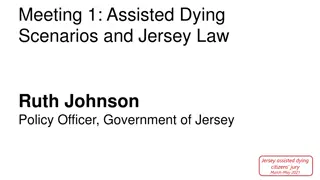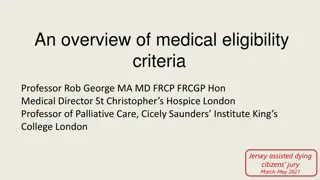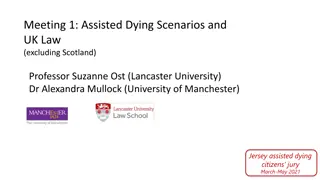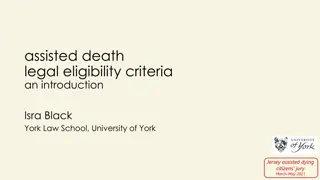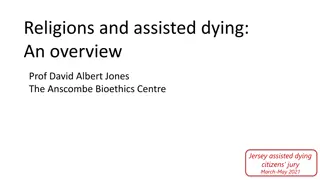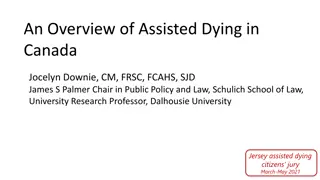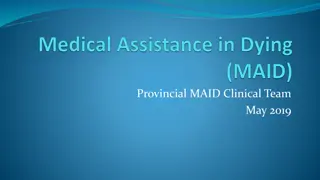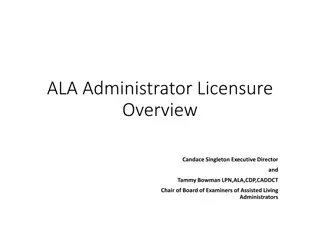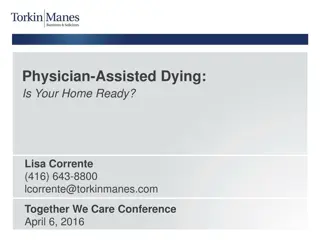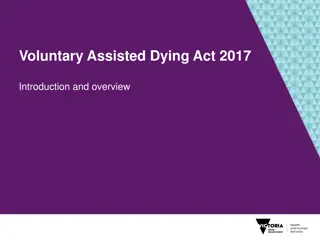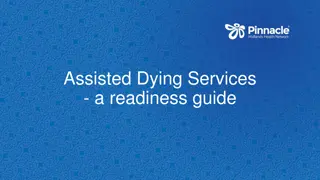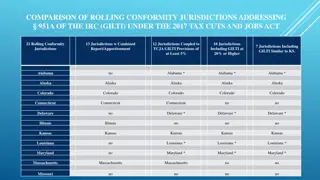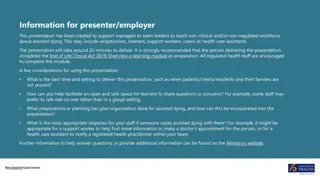An Overview of Assisted Dying in Oregon and Other U.S. Jurisdictions
The overview discusses assisted dying practices in various U.S. jurisdictions, highlighting the legal framework, terminology changes, and the role of physicians in Medical Aid in Dying (MAiD). It provides a historical timeline of states implementing assisted dying provisions, emphasizing Oregon's Death with Dignity Act. The study also delves into the ethical, legal, and societal challenges associated with end-of-life care decisions.
Download Presentation

Please find below an Image/Link to download the presentation.
The content on the website is provided AS IS for your information and personal use only. It may not be sold, licensed, or shared on other websites without obtaining consent from the author.If you encounter any issues during the download, it is possible that the publisher has removed the file from their server.
You are allowed to download the files provided on this website for personal or commercial use, subject to the condition that they are used lawfully. All files are the property of their respective owners.
The content on the website is provided AS IS for your information and personal use only. It may not be sold, licensed, or shared on other websites without obtaining consent from the author.
E N D
Presentation Transcript
An overview of assisted dying in Oregon and other U.S. jurisdictions Nancy Berlinger, PhD Research Scholar, The Hastings Center Garrison, NY, USA Prepared for Citizens Jury on Assisted Dying, Bailiwick of Jersey 20 March 2021
Research and public service work on topic Research scholar at independent research institute focused on bioethics, including ethical, legal, societal challenges arising in end-of-life care Lead author of The Hastings Center Guidelines for Treatment Decision-Making and Care Near the End of Life (2013) Working Group, Advance Decisions, University of York and University of Cardiff (2012-13) Planning Committee, Physician-Assisted Death: Scanning the Landscape and Potential Approaches A Workshop, National Academies of Sciences, Engineering, and Medicine (2017-2018) Directing research project on dementia and end-of-life choices (2019-21) 2
Terminology in the U.S. Terminology changes over time. All terms convey values; there is no neutral term. Medical Aid in Dying (MAiD) is now often used in the U.S. to describe legal provisions in Oregon and other U.S. jurisdictions. This term reflects the role of physicians ( medical ) in these provisions. Other terms used in the U.S. include: physician-assisted death (PAD), same meaning as MAiD physician-assisted suicide (PAS), now more likely to suggest opposition to legalization death with dignity, the name of the original Oregon law, is problematic (everyone has dignity) assisted dying, may refer to a process such as voluntary stopping of eating and drinking (VSED), rather than to a MAiD provision established by statute or case law and involving physicians.
1994: Oregon 2008:Washington State 2009: Montana (case law) 2013: Vermont 2015: California 2016: Colorado 2017: District of Columbia 2018: Hawaii 2019: New Jersey 2019: Maine 10 U.S. jurisdictions with asssted dying provisions Source: Thaddeus Pope, JD, PhD, HEC-C http://www.thaddeuspope.com/images/Pope_-_UKY_MAID_10-08-19.pdf.
Legal framework 1990: U.S. Supreme Court rules in Cruzan that the right of patients to refuse life-sustaining interventions the right to die is a Constitutionally protected right, applying to all states. 1994: Oregon passes Death with Dignity Act as ballot measure (voters). Implementation is delayed by court order. 1997: U.S. Supreme Court ruled in two cases (Vacco v. Quill and Washington v. Glucksberg) that assisted dying was not a Constitutionally protected right, and that states were not prohibited from permitting assisted dying. 1997: Oregon enacts Death with Dignity Act, which allows terminally-ill Oregonians to end their lives through the voluntary self-administration of lethal medications, expressly prescribed by a physician for that purpose requires the Oregon Health Authority to collect information about the patients and physicians who participate in the Act, and publish an annual statistical report. Source: About the Death with Dignity Act https://www.oregon.gov/oha/PH/ProviderPartnerResources/Evaluationresearch/de athwithdignityact/Pages/index.aspx
Eligibility criteria Key language in Oregon s statute, which is the model for most other jurisdictions in the U.S.: Terminally-ill = diagnosed with a terminal illness that will lead to death within six months. Matches eligibility for hospice enrollment in the U.S.. Safeguard against patients choosing assisted dying because they lack access to hospice. Most patients who choose assisted dying are enrolled in hospice. Oregonians = current Oregon resident. Must be 18 or older. to end their lives through the voluntary self-administration = patient must have the capacity to make a voluntary decision/give informed consent and to self-administer (be able to swallow). Ensures that patients understand the decision and has opportunity to change their mind, and safeguards against euthanasia (physician-administered), which is illegal in the U.S. of lethal medications = one or more drugs determined by the physician. Pharmacists must be informed of the purpose of the prescription. Medication availability is a challenge, as barbituates previously used have become unavailable or unaffordable. expressly prescribed by a physician for that purpose = the prescribing physician must be a Doctor of Medicine (M.D.) or Doctor of Osteopathic Medicine (D.O.) licensed to practice medicine by the Oregon Medical Board . . . Physicians are not required to provide prescriptions to patients, and participation is voluntary. Source for this slide and next slide: Death with Dignity Act: Frequently Asked Questions https://www.oregon.gov/oha/ph/providerpartnerresources/evaluationresearch/deathwithdignityact/pag es/faqs.aspx
Process/amendments to 1997 law The patient must make two oral requests to the attending physician, separated by at least 15 days. [Note: As of 2020, waived if patient s life expectancy is less than 15 days.] The patient must provide a written request to the attending physician, signed in the presence of two witnesses, at least one of whom is not related to the patient. The attending physician and a consulting physician must confirm the patient's diagnosis and prognosis. The attending physician and a consulting physician must determine whether the patient is capable of making and communicating health care decisions for him/herself; If either physician believes the patient's judgment is impaired by a psychiatric or psychological disorder (such as depression), the patient must be referred for a psychological examination; The attending physician must inform the patient of feasible alternatives to the DWDA including comfort care, hospice care, and pain control; The attending physician must request, but may not require, the patient to notify their next-of-kin of the prescription request. A patient can rescind a request at any time and in any manner. The attending physician will also offer the patient an opportunity to rescind his/her request at the end of the waiting period following the initial request to participate. Physicians must report all prescriptions for lethal medications to the Oregon Health Authority, Center for Health Statistics. Pharmacists must also be informed of the prescribed medication's ultimate use.
Use of 1997 law over last 1o years In 2011, 71 deaths occurred from ingesting medications prescribed under Oregon s Death with Dignity Act. These deaths represented 22.5 deaths per 10,000 total deaths. (0.225% of total deaths in Oregon.) In 2019, 188 deaths occurred from ingesting the prescribed medications These deaths represented 51.9 deaths per 10,000 total deaths. (0.519% of total deaths in Oregon.) In 2020, 245 deaths occurred from ingesting the prescribed medications, including 22 who had received prescriptions in previous years. [Note: Increase may reflect 2020 amendment waiving 15-day waiting period for patients with life expectancy of less than 15 days.] Demographic characteristics of DWDA patients in 2020 were similar to those of previous years: Most patients were aged 65 years or older (81%) and white (97%). Cancer still accounted for most underlying illnesses (66%). OHA made no referrals to the Oregon Medical Board for failure to comply with DWDA requirements. Sources: Oregon Health Authority, Death with Dignity 2011 annual report; 2019 annual report; 2020 data summary https://www.oregon.gov/oha/PH/PROVIDERPARTNERRESOURCES/EVALUATIONRESEARC H/DEATHWITHDIGNITYACT/Pages/ar-index.aspx
Learnings from Oregon and the U.S. Discussion is crucial before and after legalization Physicians, pharmacists, and other health care professionals need opportunities to discuss assisted dying in the context of personal and professional integrity, to reflect on whether they will participate (by prescribing or by referral to willing prescribers), and to consider how to communicate with patients who ask about or request a prescription. Public discussion should reflect on privacy/anonymity in small place where people tend to know each other. Vermont is good U.S. example. Implementation processes must be developed and continually improved Hospitals, hospice programs, pharmacists, public health authorities, etc., must work out and refine their roles with respect to public information, protocols for patient requests, clinical evaluation, patient safety, etc. Budget for data collection, analysis, and public reporting Oregon s public health reporting is viewed as trustworthy and impartial by researchers, practitioners, the public, and by people with differing views on assisted dying. Most people will not choose assisted dying.




